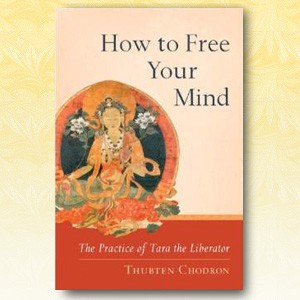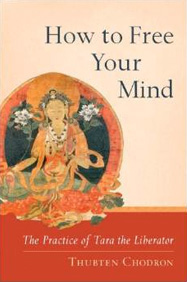The practice of Tara the liberator
An introduction and meditation

Featured on The Wheel, A Shambala Publications Blog, 12/14/2005.
Introduction
Ever since Lama Thubten Yeshe first introduced me to the meditation practice of Green Tara in 1975, I was attracted to this Buddha. Although all Buddhas have the same realizations, Tara’s appearance was very friendly and welcoming. While my mind would sometimes project its self-created authority issues on other Buddhas, admitting my imperfections to Tara didn’t bother me. Fortunately, I gradually came to feel this way about other enlightened ones, too. Lama Yeshe later explained that most Tibetan Buddhists feel close to Tara; in fact, to indicate his own affection, he called her “Mummy Tara.”
This book is written with that affection. Tara’s meditation practice has helped me through many ups and downs in my life and in my Dharma practice. My wish is to share my understanding of Tara with you in the hopes that it will help you to understand more clearly your own mind and its potential. Tara is a manifestation of what each of us can become, and as such, she shows us good qualities to cultivate on the path to enlightenment as well as obstacles to abandon.
How to Free Your Mind: The Practice of Tara the Liberator is directed toward a general audience. One need not be a Buddhist to read it or gain something from it. If you are curious about Buddhist deities, if you want to learn how to free your mind from disturbing emotions such as clinging attachment and anger, if you wonder what the nature of reality is, if you are interested in female Buddhas, you will find something of interest in these pages.
Chapter 1 introduces Tara and discusses her symbolism and the various ways in which we can view her. Chapter 2 describes the purpose of meditating on Tara and the important elements of a sadhana—or guided meditation—on Tara. Here we learn about refuge in the Three Jewels, the loving and compassionate motivation of bodhichitta, and how to visualize Green Tara and recite her mantra. Tara’s name means “liberator,” and she is said to liberate us from eight internal and eight external dangers. She does this by teaching us the ways to tame our mind so that we are not constantly befuddled by pride, ignorance, anger, jealousy, distorted views, miserliness, attachment, and doubt. Chapter 3 explains this. Chapter 4 is the Homage to the 21 Taras, praises to Tara that are frequently chanted in Tibetan monasteries and homes, and Chapter 5 contains the explanation of the Homage and the 21 manifestations of Tara. After reciting the Homage, people often chant some verses describing the benefits of reciting it. These verses and their explanation are found in Chapter 6.
Chapter 7 contains one of my favorite poems, A Song of Longing for Tara, the Infallible, written by Lama Lobsang Tenpey Gyaltsen when he was only eighteen or nineteen years old. My reflections on this moving poem are found in Chapter 8. The song gives us wise advice for Dharma practice, and following it brings us closer to Tara. Chapters 9 and 10 discuss Tara’s ultimate nature, her emptiness of inherent existence. Her ultimate nature and ours are the same, and to the extent that we realize emptiness, the afflictions obscuring our mind evaporate and we approach Tara’s enlightened state.
A glossary of important terms and a list of additional reading are resources for you to explore.
Meditation on Tara
The purpose of meditating on Tara isn’t to feel good by worshiping an external deity, “I offered apples to Tara, so I’m happy because now she’ll help me.” The ultimate purpose of showing respect and praising Tara’s qualities is to provoke us to contemplate: How can I develop those same qualities? How can I transform my mind to become more like Tara?
Seeing Tara with her right hand reaching out and her right foot extended to benefit others causes us to reflect: Do I reach out to benefit others? Do I approach others with openness? Or am I suspicious of them and need to check things out to see if I’m safe first? Her image acts as a mirror for us to examine ourselves and to contemplate how we can approach others with an open hand and kind heart. What attitudes and emotions do we need to develop so that we will have a more open attitude toward others and can approach them with more acceptance, respect, and affection? What are some small things that we can do in our lives that would indicate these attitudes and emotions? These questions lead us back into the lamrim, the gradual path to enlightenment, which describes how to develop those excellent qualities.
Homage to you whose eyes, the sun and moon,
Radiate with pure brilliant light;
Uttering hara twice and tuttara
Dispels extremely fearful plagues.
This Tara is Tara the Source of All Attainments. She is orange and grants the power to make oneself invisible. She also cures horrible diseases. This verse praises her activity of dispelling fever and epidemic diseases. Just as chronic fevers and certain illnesses drag on and one is not able to shake them off, so too, cyclic existence drags on and flares up. Here, her right eye is like the sun and symbolizes her fierce aspect. Her left eye is gentle like the moon, symbolizing her peaceful aspect. “Reciting hara twice” means reciting the fierce mantra (om nama tare namo hare hum hare soha) and “reciting … tuttara” means reciting the peaceful mantra (om tare tuttare ture soha). By reciting these two, powerful illnesses are overcome.
When we are ill, thinking of both the fierce and the peaceful aspects of Tara and reciting both mantras are helpful. This meditation is good for illnesses such as cancer, AIDS, environmental pollution, new diseases that are appearing now, and illnesses that are very difficult to cure.
In Chinese and Tibetan medicine, illnesses are either heating or cooling. If it’s a cooling illness and one has too much cooling energy, then meditate on the fierce Tara with her right eye like the sun and it heats you up. If you have too much heat energy, then meditate on the peaceful Tara with her left eye like the moon. This is cooling just like moonbeams are cooling. Imagine such light coming into you or whoever is sick, curing all illnesses.
Venerable Thubten Chodron
Venerable Chodron emphasizes the practical application of Buddha’s teachings in our daily lives and is especially skilled at explaining them in ways easily understood and practiced by Westerners. She is well known for her warm, humorous, and lucid teachings. She was ordained as a Buddhist nun in 1977 by Kyabje Ling Rinpoche in Dharamsala, India, and in 1986 she received bhikshuni (full) ordination in Taiwan. Read her full bio.


